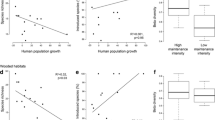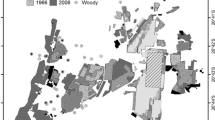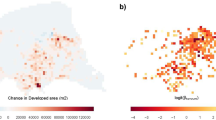Abstract
The importance of the spatial as well as the temporal structure of habitat patches for urban biodiversity has been recognised, but rarely quantified. In dynamic environments the rate of habitat destruction and recreation (i.e. the landscape turnover rate), the minimum amount of potential habitat, its spatial configuration as well as the environmental conditions determining habitat quality are crucial factors for species occurrence. We analysed species responses to environmental parameters and to the spatio-temporal configuration of urban brownfield habitats in a multi-species approach (37 plant and 43 insect species). Species presence/absence data and soil parameters, site age, vegetation structure and landscape context were recorded by random stratified sampling at 133 study plots in industrial areas in the city of Bremen (Germany). Based on the field data, we predicted species occurrences by species distribution models using a multi-model inference approach. Predicted species communities were driven by successional age both at the scale of a single building lot and at the landscape scale. Minimum average succession time of brownfield habitats required to support all and especially regionally rare species depended on the proportion of available open space; the larger the potential habitat area the faster the acceptable turnover. Most plant, grasshopper, and leafhopper species modelled could be maintained at an intermediate turnover rate (mean age of 10–15 years) and a proportion of open sites of at least 40%. Our modelling approach provides the opportunity of inferring optimal spatio-temporal landscape configurations for urban conservation management from patch scale species-environment relationships. The results indicate that urban planning should incorporate land use dynamics into the management of urban biodiversity.






Similar content being viewed by others
References
Akçakaya HR, Radeloff VC, Mlandenoff DJ et al (2004) Integrating landscape and metapopulation modeling approaches: viability of the sharp-tailed grouse in a dynamic landscape. Conserv Biol 18(2):526–537
Angold PG, Sadler JP, Hill MO et al (2006) Biodiversity in urban habitat patches. Sci Total Environ 360(1–3):196–204
Bastin L, Thomas CD (1999) The distribution of plant species in urban vegetation fragments. Landsc Ecol 14(5):493–507
Biedermann R (2004) Modelling the spatial dynamics and persistence of the leaf beetle Gonioctena olivacea in dynamic habitats. Oikos 107(3):645–653
Boulesteix AL (2004) PLS dimension reduction for classification with microarray data. Stat Appl Genet Mol Biol 3(1):33
Bundesamt für Naturschutz (BfN) (2004) FloraWeb—Daten und Informationen zu Wildpflanzen und zur Vegetation Deutschlands (Data and information on the wild plants and vegetation of Germany). http://www.floraweb.de
Burnham KP, Anderson (2002) Model selection and multimodel inference: a practical information-theoretic approach, 2nd edn. Springer, New York
Chytrý M, Tichý L, Holt J et al (2002) Determination of diagnostic species with statistical fidelity measures. J Veg Sci 13(1):79–90
Cook WM, Yao J, Foster BL et al (2005) Secondary succession in an experimentally fragmented landscape: community patterns across space and time. Ecology 86(5):1267–1279
Corsi F, de Leeuw J, Skimore A (2000) Modeling species distribution with GIS. In: Boitani L, Fuller TK (eds) Research techniques in animal ecology. Columbia University Press, New York, pp 389–434
Empter J (2006) Umnutzungsraten in Industriegebieten und deren Einfluss auf Brachflächen: Eine luftbildgestützte Erfassung von Nutzungsänderungen und Möglichkeite einer Nutzung industriell-gewerblicher Brachflächen im Rahmen des Stadtnaturschutzes. Diploma thesis, University of Oldenburg, Landscape Ecology Group
Eyre MD, Luff ML, Woodward JC (2003) Beetles (Coleoptera) on brownfield sites in England: an important conservation resource? J Insect Conserv 7:223–231
Ferrier S, Drielsma M, Manion G et al (2002a) Extended statistical approaches to modelling spatial pattern in biodiversity in northeast New South Wales. II. Community-level modelling. Biodivers Conserv 11(12):2309–2338
Ferrier S, Watson G, Pearce J et al (2002b) Extended statistical approaches to modelling spatial pattern in biodiversity in northeast New South Wales. I. Species-level modelling. Biodivers Conserv 11(12):2275–2307
Fielding AH, Bell JF (1997) A review of methods for the assessment of prediction errors in conservation presence/absence models. Environ Conserv 24(1):38–49
Garden J, McAlpine C, Peterson A et al (2006) Review of the ecology of Australian urban fauna: a focus on spatially explicit processes. Austral Ecol 31(2):126–148
Gibson CWD (1998) Brownfield: red data. The values artificial habitats have for uncommon invertebrates. English Nature Research Report no. 273, English Nature, Peterborough
Gibson LA, Wilson BA, Cahill DM et al (2004) Spatial prediction of rufous bristlebird habitat in a coastal heathland: a GIS-based approach. J Appl Ecol 41(2):213–223
Godefroid S, Koedam N (2007) Urban plant species patterns are highly driven by density and function of built-up areas. Landsc Ecol 22(8):1227–1239
Grand J, Buonaccorsi J, Cushman SA et al (2004) A multiscale landscape approach to predicting bird and moth rarity hotspots, in a threatened pitch pine-scrub oak community. Conserv Biol 18(4):1063–1077
Guisan A, Thuiller W (2005) Predicting species distribution: offering more than simple habitat models. Ecol Lett 8(9):993–1009
Guisan A, Zimmermann NE (2000) Predictive habitat distribution models in ecology. Ecol Model 135(2–3):147–186
Harrell FEJ (2001) Regression modeling strategies: with applications to linear models, logistic regression, and survival analysis. Springer, New York
Heinze G, Ploner M (2004) A SAS macro, S-Plus library and R package to perform logistic regression without convergence problems. Technical report, Medical University of Vienna, Department of medical computer sciences, Section of clinical biometrics
Hochkirch A, Klugkist H (1998) Die Heuschrecken des Landes Bremen—ihre Verbreitung, Habitate und ihr Schutz (Orthoptera: Saltatoria). Abh Naturw Verein Bremen 44(1):3–73
Hosmer D, Lemeshow S (2000) Applied logistic regression, 2nd edn. Wiley, New York
Jeltsch F, Moloney KA, Schurr FM et al (2008) The state of plant population modelling in light of environmental change. Perspect Plant Ecol Evol Syst 9(3–4):171–189
Keymer JE, Marquet PA, Velasco-Hernandez JX et al (2000) Extinction thresholds and metapopulation persistence in dynamic landscapes. Am Nat 156(5):478–494
Kleyer M, Biedermann R, Henle K et al (2007) Mosaic cycles in agricultural landscapes of Northwest Europe. Basic Appl Ecol 8(4):295–309
Manel S, Williams HC, Ormerod S (2001) Evaluating presence-absence models in ecology: the need to account for prevalence. J Appl Ecol 38:921–931
Muratet A, Machon N, Jiguet F et al (2007) The role of urban structures in the distribution of wasteland flora in the Greater Paris Area, France. Ecosystems 10(4):661–671
Olden JD (2003) A species-specific approach to modeling biological communities and its potential for conservation. Conserv Biol 17(3):854–863
Olden JD, Joy MK, Death RG (2006) Rediscovering the species in community-wide predictive modeling. Ecol Appl 16(4):1449–1460
Peppler-Lisbach C, Schröder B (2004) Predicting the species composition of Nardus stricta communities by logistic regression modelling. J Veg Sci 15(5):623–634
Prach K, Rehounková K (2006) Vegetation succession over broad geographical scales: which factors determine the patterns? Preslia 78(4):469–480
Radford JQ, Bennett AF (2004) Thresholds in landscape parameters: occurrence of the white-browed treecreeper Climacteris affinis in Victoria, Australia. Biol Conserv 117(4):375–391
Roy M, Pascual M, Levin SA (2004) Competitive coexistence in a dynamic landscape. Theor Popul Biol 66(4):341–353
Rushton SP, Ormerod SJ, Kerby G (2004) New paradigms for modelling species distributions? J Appl Ecol 41:193–200
Schadek U, Strauss B, Biedermann R et al (2009) Species richness, vegetation structure and soil resources of urban brownfield sites linked to succesional age. Urban Ecosyst 12(2):115–126
Small EC, Sadler JP, Telfer MG (2003) Carabid beetle assambalges on urban derelict sites in Birmingham, UK. J Insect Conserv 6:233–246
Small E, Sadler JP, Telfer M (2006) Do landscape factors affect brownfield carabid assemblages? Sci Total Environ 360(1–3):205–222
Snäll T, Ehrlén J, Rydin H (2005) Colonization-extinction dynamics of an epiphyte metapopulation in a dynamic landscape. Ecology 86(1):106–115
Strauss B, Biedermann R (2006) Urban brownfields as temporary habitats: driving forces for the diversity of phytophagous insects. Ecography 29:928–940
Strauss B, Biedermann R (2007) Evaluating temporal and spatial generality: how valid are species–habitat relationship models? Ecol Mod 204:104–114
Venables WN, Ripley BD (1999) Modern applied statistics with S-PLUS, 3rd edn. Springer, New York
Wilcox C, Cairns BJ, Possingham HP (2006) The role of habitat disturbance and recovery in metapopulation persistence. Ecology 87(4):855–863
Wimberly MC (2006) Species dynamics in disturbed landscapes: when does a shifting habitat mosaic enhance connectivity? Landsc Ecol 21(1):35–46
Wintle BA, Elith J, Potts JM (2005) Fauna habitat modelling and mapping: a review and case study in the Lower Hunter Central Coast region of NSW. Austral Ecol 30(7):719–738
Wood BC, Pullin AS (2002) Persistence of species in a fragmented urban landscape: the importance of dispersal ability and habitat availability for grassland butterflies. Biodivers Conserv 11(8):1451–1468
Acknowledgments
This study was conducted as part of the TEMPO project and was financially supported by the German Ministry of Education and Research (BMBF, grant 01LM0210). We thank Cord Peppler-Lisbach for helpful comments on species fidelity to vegetation types and Ute Schadek for providing soil and plant composition data.
Author information
Authors and Affiliations
Corresponding author
Electronic supplementary material
Below is the link to the electronic supplementary material.
Rights and permissions
About this article
Cite this article
Kattwinkel, M., Strauss, B., Biedermann, R. et al. Modelling multi-species response to landscape dynamics: mosaic cycles support urban biodiversity. Landscape Ecol 24, 929–941 (2009). https://doi.org/10.1007/s10980-009-9371-7
Received:
Accepted:
Published:
Issue Date:
DOI: https://doi.org/10.1007/s10980-009-9371-7




